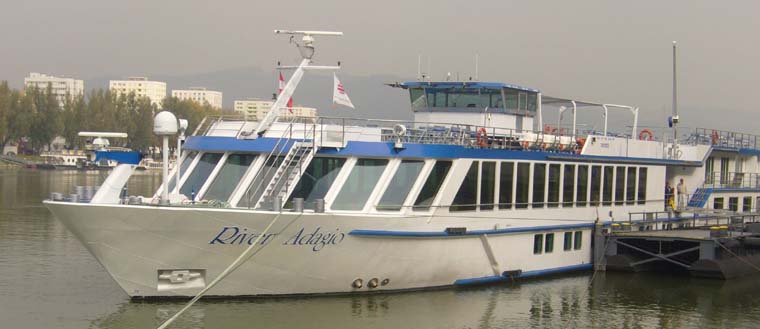|
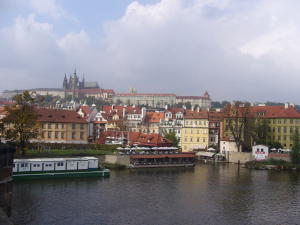 The
first six days of our trip were spent in the beautiful city of Prague,
Czech Republic (part of the old Czechoslovakia). The Czech Republic
has been a member of the European Union since 2004 but has its own
money - the Crown. There were about 20 Crowns to $1. They expect
to convert to the Euro in 2010. The
first six days of our trip were spent in the beautiful city of Prague,
Czech Republic (part of the old Czechoslovakia). The Czech Republic
has been a member of the European Union since 2004 but has its own
money - the Crown. There were about 20 Crowns to $1. They expect
to convert to the Euro in 2010.
Prague has a long and turbulent history. It came into prominence
in 1232 when King Wenceslas established a settlement there. Under
Emperor Charles IV in the 14th century Prague became one of the
most splendid cities in Europe. Its location at the intersection
of vital trade routes stimulated its economy. It was home to many
of the emperors of the Holy Roman Empire and a vital center for
the Hapsburgs. Although occupied by the Germans in WWII, it suffered
little structural damage because Hiler loved Prague. Thus it is
one of most well preserved capitals in Europe.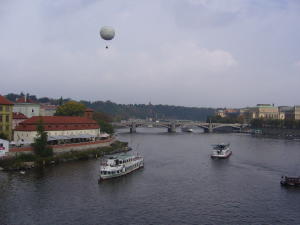
Today, Prague has about 1.2 M people. Most people live in the suburbs,
taking one of the many forms of public transportation into the center.
Our Hotel Don Giovanni was located outside the downtown area and
we learned to take the subway into town for less than $1 roundtrip.
The subway was actually built by the Russians deep under the city
and it was definitely the fastest way to get around. We felt very
safe in Prague but we were warned to watch for pickpockets. Evidently
this is a major problem and we were given tips on how to avoid becoming
a victim.
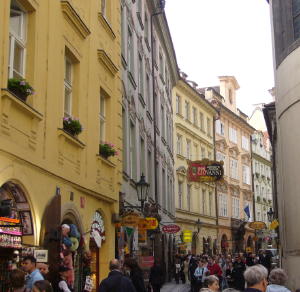 Our
first day in Prague we enjoyed a walking tour of the old town (Stare
Mesto) area. We walked down winding, narrow, medieval streets made
of cobblestones Our
first day in Prague we enjoyed a walking tour of the old town (Stare
Mesto) area. We walked down winding, narrow, medieval streets made
of cobblestones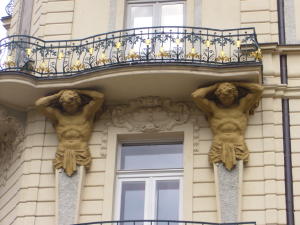 .
It seemed like every building we passed had an interesting style,
many adorned with paintings or sculptures. It seemed like every
other store was selling jewelry of amber and garnets, or bohemian
glass crystal. Also popular were fur hats, pashmima scarves, carved
wooden marionettes and stacked Russian dolls. Since it was a lot
colder than we expected, Barb quickly bought a beautiful scarf that
she wore just about every day of the trip! .
It seemed like every building we passed had an interesting style,
many adorned with paintings or sculptures. It seemed like every
other store was selling jewelry of amber and garnets, or bohemian
glass crystal. Also popular were fur hats, pashmima scarves, carved
wooden marionettes and stacked Russian dolls. Since it was a lot
colder than we expected, Barb quickly bought a beautiful scarf that
she wore just about every day of the trip!
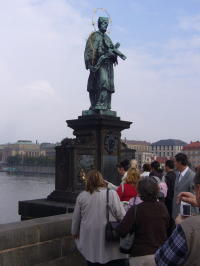 The
Vltava River flows through Prague and divides the city. Seven bridges
cross the river, the most famous of which is the Charles Bridge. The
Vltava River flows through Prague and divides the city. Seven bridges
cross the river, the most famous of which is the Charles Bridge.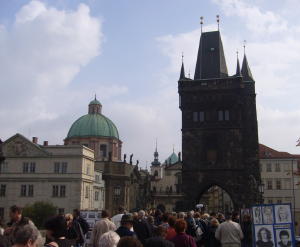 It
was built in the 14th century and took 50 years to build. The bridge
has huge gothic towers at each end and many statues along its span.
It is strictly a pedestrian bridge now and artists line the bridge
selling photos, paintings and jewelry. As you can see the bridge
and the area surrounding it were always very crowded even though
this was off season. It
was built in the 14th century and took 50 years to build. The bridge
has huge gothic towers at each end and many statues along its span.
It is strictly a pedestrian bridge now and artists line the bridge
selling photos, paintings and jewelry. As you can see the bridge
and the area surrounding it were always very crowded even though
this was off season.
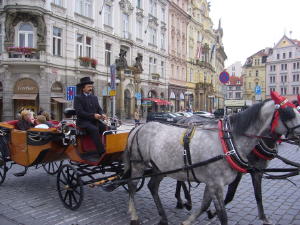 The
Old town Square has an astronomical clock built in the 15th century. The
Old town Square has an astronomical clock built in the 15th century.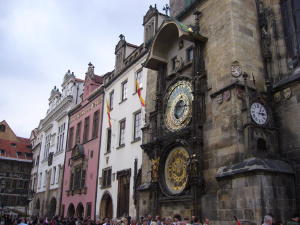 It
rings on the hour with figures that come out and dance. It
rings on the hour with figures that come out and dance.
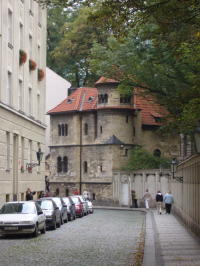 We
walked through the Jewish Quarter but it was during holy days so
we couldn't visit the old cemetery or synagogue. We
walked through the Jewish Quarter but it was during holy days so
we couldn't visit the old cemetery or synagogue.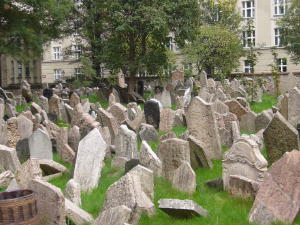 But we peaked through the fence and saw all the gravestones. It
is estimated that over 200,000 graves are contained there, the earliest
stone is dated 1493.
But we peaked through the fence and saw all the gravestones. It
is estimated that over 200,000 graves are contained there, the earliest
stone is dated 1493.
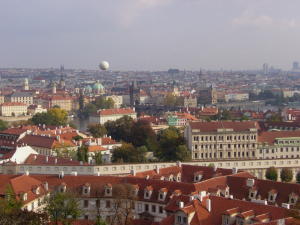 Crossing
over the Charles Bridge, we climbed up to the Castle District. This
is home to Prague Castle, the largest ancient castle in the world. Crossing
over the Charles Bridge, we climbed up to the Castle District. This
is home to Prague Castle, the largest ancient castle in the world.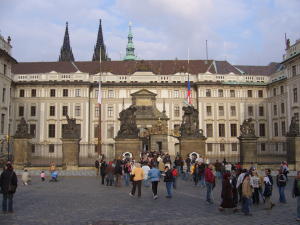 It was constructed in the 9th century and contains the Royal Palace,
the Gardens and St. Vitus Cathedral. The Royal Palace was the seat
of princes and kings until the end of the 16th century and each
succeeding ruler added on to the palace in their own style. St.
Vitus Cathedral was built in 1344 by Charles IV.
It was constructed in the 9th century and contains the Royal Palace,
the Gardens and St. Vitus Cathedral. The Royal Palace was the seat
of princes and kings until the end of the 16th century and each
succeeding ruler added on to the palace in their own style. St.
Vitus Cathedral was built in 1344 by Charles IV. 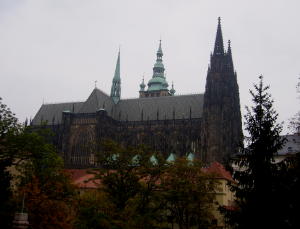 This
gothic cathedral is the largest in Prague and dominates the skyline.
It has gorgeous stained glass windows throughout. This
gothic cathedral is the largest in Prague and dominates the skyline.
It has gorgeous stained glass windows throughout.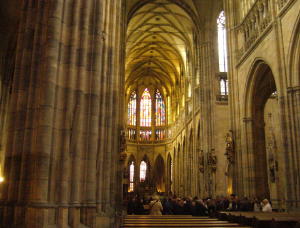
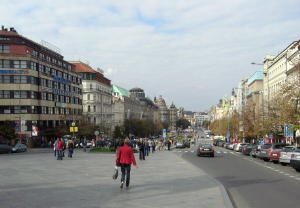 Wenceslas
Square in the New Town area (Nove Mesto) is the modern business
center of Prague. A pedestrian street runs through the square with
shops on each side, most very high end. However, as in most of Europe,
you can always find a McDonalds! Wenceslas
Square in the New Town area (Nove Mesto) is the modern business
center of Prague. A pedestrian street runs through the square with
shops on each side, most very high end. However, as in most of Europe,
you can always find a McDonalds!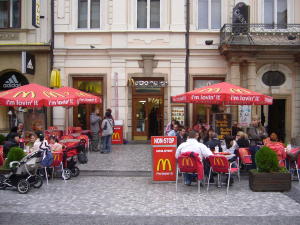
To view additional photos from Prague, visit the Prague
Photo Gallery.
While in Prague we took several side trips outside the city.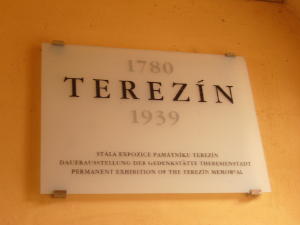 The first was to Terezin, about 90 miles north of the city. The
town was originally built in 1780 by Emperor Joseph II of Austria
for protection against the Germans. It consists of a big fortress
and a small fortress.
The first was to Terezin, about 90 miles north of the city. The
town was originally built in 1780 by Emperor Joseph II of Austria
for protection against the Germans. It consists of a big fortress
and a small fortress.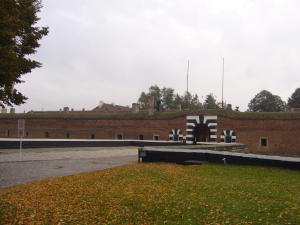 But during WWII, the Prague Gestapo Police Prison was set up in
the small fortress for political dissidents.
But during WWII, the Prague Gestapo Police Prison was set up in
the small fortress for political dissidents.
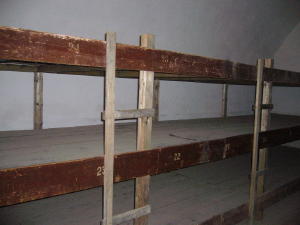 One
cell held about 60-90 inmates on wooden, 4 level bunks, with one
hole for human waste. Over 2600 prisoners died in Terezin due to
the harsh living conditions, diseases and torture by the guards.
The large fortress town became a ghetto for Jews. One
cell held about 60-90 inmates on wooden, 4 level bunks, with one
hole for human waste. Over 2600 prisoners died in Terezin due to
the harsh living conditions, diseases and torture by the guards.
The large fortress town became a ghetto for Jews. 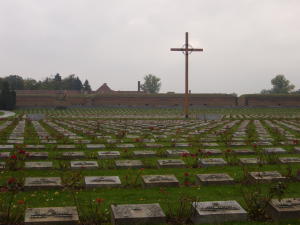 While
there were no gas chambers in Terezin it was used as a staging area
for Jews to be sent to Auschwitz. And with nearly 60,000 Jews inhabiting
an area originally designed for 7,000, extremely close quarters,
diseases and lack of food and water made it truly like a concentration
camp. The inhabitants were some of Europe's most gifted composer,
writers and artists. Of 87,000 Jews taken to Terezin, only 4000
survived. In 1945, a National Cemetery was laid out in front of
the small fortress, with the remains of over 10,000 victims of the
Prison, the Ghetto and the concentration camp in Litomerice. While
a very sobering tour, the highlight was seeing the drawings and
poetry of some of the children that were smuggled out of the ghetto.
For more photos from Terezin, visit the Terezin
Photo Gallery. While
there were no gas chambers in Terezin it was used as a staging area
for Jews to be sent to Auschwitz. And with nearly 60,000 Jews inhabiting
an area originally designed for 7,000, extremely close quarters,
diseases and lack of food and water made it truly like a concentration
camp. The inhabitants were some of Europe's most gifted composer,
writers and artists. Of 87,000 Jews taken to Terezin, only 4000
survived. In 1945, a National Cemetery was laid out in front of
the small fortress, with the remains of over 10,000 victims of the
Prison, the Ghetto and the concentration camp in Litomerice. While
a very sobering tour, the highlight was seeing the drawings and
poetry of some of the children that were smuggled out of the ghetto.
For more photos from Terezin, visit the Terezin
Photo Gallery.
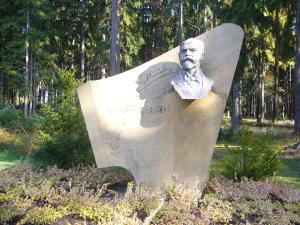 Czechoslovakia
was home to the famous composer Antonin Dvorak. The house of his
brother-in-law where Dvorak spent a lot of time has been turned
into a museum with memorabilia from his life and operas. Czechoslovakia
was home to the famous composer Antonin Dvorak. The house of his
brother-in-law where Dvorak spent a lot of time has been turned
into a museum with memorabilia from his life and operas. 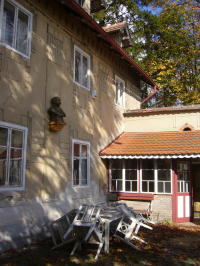 We
were fortunate to also tour his personal home where he spent many
summers. This is normally not open to the public but we were privileged
to see it under the guidance of his grandson. Both homes are located
in a beautiful park-like setting about 45 minutes from Prague. To
view additional photos of the Dvorak home, go to the Dvorak
Photo Gallery. We
were fortunate to also tour his personal home where he spent many
summers. This is normally not open to the public but we were privileged
to see it under the guidance of his grandson. Both homes are located
in a beautiful park-like setting about 45 minutes from Prague. To
view additional photos of the Dvorak home, go to the Dvorak
Photo Gallery.
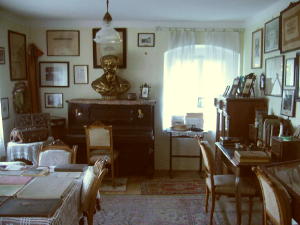
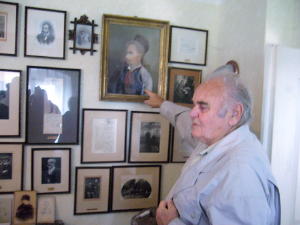
We also visited the village of Nelahzeve, a town of 1350 people.
It was the birthplace of Dvorak and we visited the house where he
grew up. But the highlight of the trip was a visit to the village
school. The school has about 50 children ages 6-10 in 5 grades.
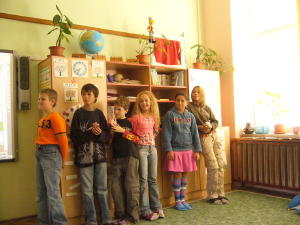 We
participated in an English class where the children were learning
colors.Grand Circle Travel had donated an interactive computer touch
screen board that made learning fun. We
participated in an English class where the children were learning
colors.Grand Circle Travel had donated an interactive computer touch
screen board that made learning fun.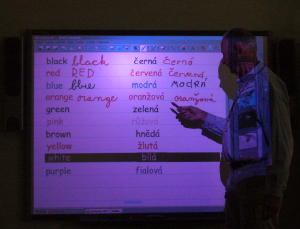 Both Fred and I were chosen to join the children in interactive
exercises and games using the board to identify colors in English.
Then we visited a music class where the children sang songs. We
ate lunch with the children in the school cafeteria. We learned
that school is compulsory until age 15. Then there is 4 years of
secondary school following either a college prep, specialist or
vocational tract. To graduate, they must pass a 2 hour oral exam
and have 1 foreign language. To see more photos from our visit to
the school, go to School Visit
Photo Gallery.
Both Fred and I were chosen to join the children in interactive
exercises and games using the board to identify colors in English.
Then we visited a music class where the children sang songs. We
ate lunch with the children in the school cafeteria. We learned
that school is compulsory until age 15. Then there is 4 years of
secondary school following either a college prep, specialist or
vocational tract. To graduate, they must pass a 2 hour oral exam
and have 1 foreign language. To see more photos from our visit to
the school, go to School Visit
Photo Gallery.
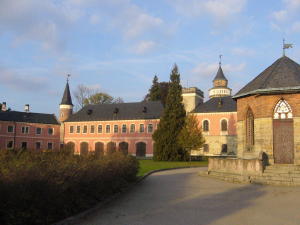 Sychrov
Castle is located about 50 miles from Prague and was the summer
palace of Duke Kamil Rohan. The castle was originally built in the
16th century and was gradually added on to Sychrov
Castle is located about 50 miles from Prague and was the summer
palace of Duke Kamil Rohan. The castle was originally built in the
16th century and was gradually added on to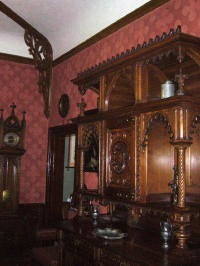 .
It has been beautifully restored and contains hand carved furniture,
ceiling panels and balustrades by the artist Busek. We listened
to an organ concert in the castle's chapel, then had a delicious
dinner in the castle dining hall. To see more photos from Sychrov
Castle, go to Sychrov Castle Photo
Gallery. .
It has been beautifully restored and contains hand carved furniture,
ceiling panels and balustrades by the artist Busek. We listened
to an organ concert in the castle's chapel, then had a delicious
dinner in the castle dining hall. To see more photos from Sychrov
Castle, go to Sychrov Castle Photo
Gallery.
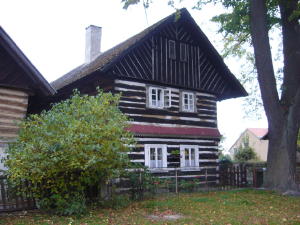 Our
final side trip was to the Czech village of Nosalov, one of the
best preserved historical villages in the countryside. We passed
fields of hops for the world famous Czech beer (the Czech Republic
has the highest consumption of beer per capita in the world.) The
village was a great place to view the traditional timbered farmhouses
from the 17th century. Our
final side trip was to the Czech village of Nosalov, one of the
best preserved historical villages in the countryside. We passed
fields of hops for the world famous Czech beer (the Czech Republic
has the highest consumption of beer per capita in the world.) The
village was a great place to view the traditional timbered farmhouses
from the 17th century.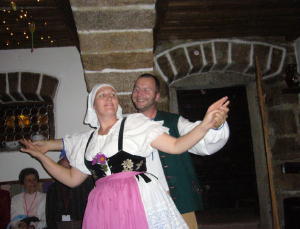 We enjoyed an evening of folk music and polka dancing along with
a traditional dinner.To view more photos from this visit, go to
Nosalov Photo Gallery.
We enjoyed an evening of folk music and polka dancing along with
a traditional dinner.To view more photos from this visit, go to
Nosalov Photo Gallery.
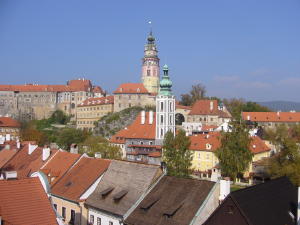 On
the way from Prague to board the ship in Linz, Austria, we stopped
in the medieval town of Cesky Krumlov. This is a UNESCO World Cultural
Heritage Monument and one of the most picturesque places we visited
on the trip. On
the way from Prague to board the ship in Linz, Austria, we stopped
in the medieval town of Cesky Krumlov. This is a UNESCO World Cultural
Heritage Monument and one of the most picturesque places we visited
on the trip. 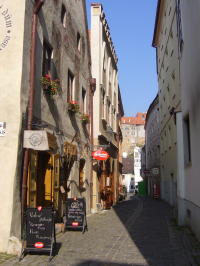 The
castle was developed starting in the 14th century. We wandered down
the winding cobblestone streets with their cute shops. Then had
lunch at the Eggenberg Brewery before reboarding the bus for Linz.
To view more photos from Cesky Krumlov, go to Cesky
Krumlov photo gallery. The
castle was developed starting in the 14th century. We wandered down
the winding cobblestone streets with their cute shops. Then had
lunch at the Eggenberg Brewery before reboarding the bus for Linz.
To view more photos from Cesky Krumlov, go to Cesky
Krumlov photo gallery.
Home
Locations Visited Photos Map
Contact Us
|
